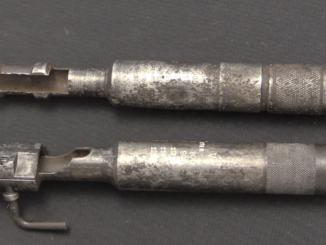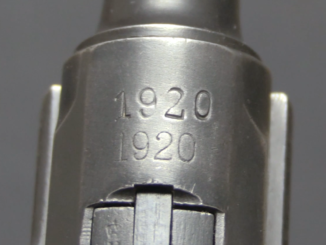This rifle sold for $4,600 at Rock Island on December 2, 2018.
The Zeiss 2.5x Glasvizier 16 optic is one of the most unusual and interesting of the German sighting systems used on rifles during the First World War. It is a bifocal optic, working in the same way as today’s SeeAll optic. Basically, a section of magnifying lens sits in the bottom third of the field of view, which magnifies the huge white triangle that clips over the rifle’s front sight. By lining the tip of this triangle up on your target, you can get a parallax-free sight picture. The front and rear portions are both clip-on and can be removed in seconds, allowing the system to be fielded without needing to permanently convert rifles to a sniper configuration. The system is interesting and does work, but like its SeeAll descendent today, it is not really what someone expects to get from a 2.5s optical sight. I don’t have any data on the number produced or the extent to which they were fielded during the war (although this particular optic is serialized #4807), but I suspect that its unorthodox nature led to a poor reputation amongst troops and a fairly limited field use. Certainly these are one of the rarest f the German WW1 optics, and one would expect to see more surviving if they had been widely used.
Want to try out this sort of optics sight on a gun of your own, without paying the WW1 historical premium? The SeeAll works the same way, and you can find them here: https://seeallopensight.com
You can also check out today’s review of the SeeAll over on InRangeTV:
Contact:
Forgotten Weapons
PO Box 87647
Tucson, AZ 85754




No optical sight is idiot-proof. I suspect that most soldiers who used the sight had to keep the user manual nearby, because it wasn’t like the usual telescope. I could be wrong.
Very interesting Ian!! Thanks for the info on the See All sight, I just ordered one to try out, looking forward to seeing how well it works.
The fact that the ZF40/41 showed up in WW2 shows that the German Army understood the advantages of low-power long eye relief (LER) optical sights in “snap-shoot” situations.
Years ago, there was a custom of putting such low-power scopes as the Bushnell Phantom 1.5Xrevolver/pistol sight or the old LER version of the Lyman Alaskan 2.5X on Winchester Model 1894 lever-actions out on the barrel, replacing the buckhorn rear iron sight. The idea of course was to have a telescopic sight that did not interfere with the ’94’s upward case ejection. The ’94 Angle Eject “solved” that problem.
Years ago, I mounted a Bushnell 1.5-5x scope in “see-through” mounts on a Marlin 1895 .45-70. When it was zeroed at 100 yards, with the scope dialed down to 1.5X, if you just kept your head erect, threw the rifle up to your shoulder, and kept both eyes open, with one eye in line with the scope you’d see a ghost image of the crosshairs in your field of view. And at 100 yards or less, that rather hefty 405-grain bullet would go exactly where you laid that “ghost” crosshair; the 300-grain hollowpoint hit about an inch lower.
Not gilt-edged accuracy, but quite adequate for a “stopping rifle”.
cheers
eon
Eye relief is something that most people don’t seem to understand until they get whacked in the face by the eyepiece. If you need stopping power, you certainly don’t want it to stop you from being able to see what you’re shooting.
I bought a ambient See-All a couple years ago when it first came out, and quickly benched it as a backup sight. Without separate illumination, it is a bit harder to acquire and use than a simple peep sight. That’s my mileage anyway — others may differ. I hope you’ll have the opportunity to review more early optics like the Nydar and Giese electric gunsights.
Amazing article. everyone should need to know the impotent fact before the buying a Germany’s WW1 Zeiss Bifocal Scope. You wrote the awesome impotent fact in this article.
I also found some helpful article about Germany’s WW1 Zeiss Bifocal Scope
Thanks